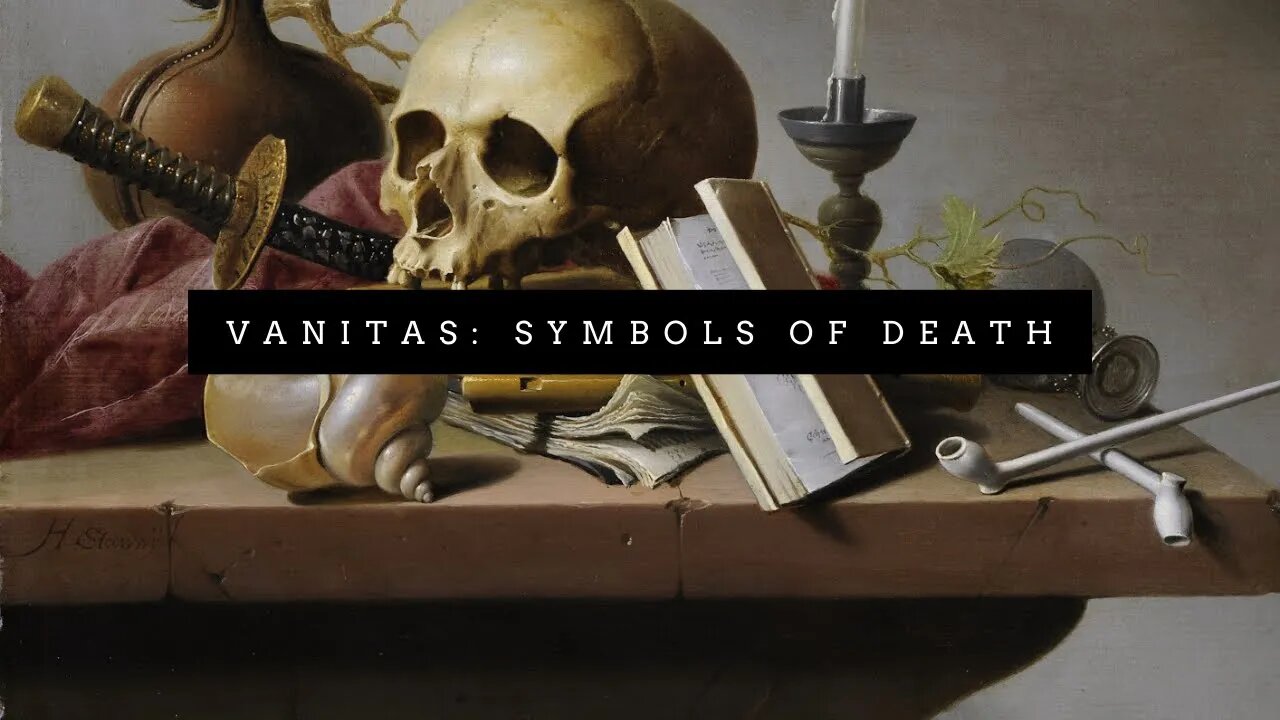Premium Only Content

Decorating with Death | The Depressing World of VANITAS Paintings (Memento Mori Part I)
It seems to be generally true that anytime you encounter a religion, you will find at some point within its vast and complex framework of metaphysics, morality, and rituals, a place in that framework that seeks to come to terms in some way with death and to remind people of the basic fact of death. When you encounter a culture in which religion has become foundational, you will find artistic representations of these metanarratives of life and death, begging and end, and the (often transitory) nature of reality. I mentioned Buddhist sand mandalas in my video on Unus Annus. There’s also Japanese death poems and the Mexican day of the dead. Artifacts and festivals of this nature are found the whole world over. But In this video I want to focus on European art, particulaellu on Vanitas Paintings.
A vanitas painting is a work of art that highlights the transitory nature of the things or people that it portrays in order to remind us of the brevity of life and bring us into greater harmony with the nature of life, which for humans is fleeting.
The term Vanitas comes from the Latin translation of the Hebrew book of Ecclesiastes, which translates the Hebrew word ‘hebel’ (‘breath’) as vanitas, which Many English translations render as the word vanity. "All is vanity,” says Ecclesiastes. Everything is like breath. The Hebrew word ‘hebel’ here is pregnant with meaning and can indicate that everything is meaningless, or that everything is obscure or mysterious, that everything is absurd, or that everything is as brief as a single human breath. For our purposes, we'll focus on this latter meaning.
Various objects are used to symbolize the brevity of life: bubbles might represent the shortness of play, flowers the shortness of beauty, with skulls representing the shortness of life itself. Globes highlight the transitory nature of the world itself. The volume of objects alone can indicate how easy it is to become distracted by all of these things in life. The end of pleasure is represented by silent musical instruments, scattered playing cards, pipes, or empty, upended goblets, indicating that someone’s drink has been interrupted. The vanity of wealth is symbolized with jewels or coins. The brevity and emptiness of knowledge itself is symbolized by books.
It’s worth bearing in mind that these painting would likely be displayed in a person’s home. These were not meant strictly for churches or public spaces but for private houses—a bit morose. But it also reflects an everyday symbolic sophistication that I think is largely lacking in the modern world. Our homes, our dwelling places, are not as symbolically rich and layered as even pagan dwellings with household gods.
SOCIAL MEDIA LINKS
Instagram: https://www.instagram.com/empire_of_the_mind/
Facebook: https://www.facebook.com/Empire-of-the-Mind-102111168633434/
Patreon: https://www.patreon.com/EmpireoftheMind
ART IN ORDER OF APPEARANCE
Vanitas Still Life with a Tulip, Skull and Hour-Glass Giclee Print by Philippe De Champaigne
St. Jerome in His Study by Albrecht Dürer (1521)
Flammarion Engraving
Harmony of the spheres showing the conformity between the world and planets, including the sun and the moon: "De anima mundi et de concordia planetarium"
La Calavera Catrina or Catrina La Calavera Garbancera ('Dapper Skeleton', 'Elegant Skull') (1910–1913)
Still Life: An Allegory of the Vanities of Human Life' by Harmen Steenwyck
Large Vanitas by Pieter Boel
King Solomon and the Iron Worker' by Christian Schussele, 1863
Allegory by Karel Dujardin 1663
A boy blowing soap bubbles by Caspar Netscher, 1679
Two Boys blowing Bubbles by Caspar Netscher
Soap Bubbles ca. 1733–34 by Jean Siméon Chardin
Flower Still-Life with Curtain by Adriaen van der Spelt
Vanitas painting, selfportrait most probably Clara Peeters
Vanitas still life with a globe, sceptre, a skull crowned with straw by Hendrick Andriessen
Allegory of Charles I of England and Henrietta of France in a Vanitas Still Life by Anonymous
Vanitas-Still Life, Oosterwijck
Vanitas still life with a skull, sheet music, violin, globe, candle, hourglass and playing cards, all on a draped table by Cornelis Norbertus Gijsbrechts
A Vanitas by Edward Collier
Vanitas by Harmen Steenwijck, circa 1640
Vanitas - Still Life with Bouquet and Skull by Adriaen van Utrecht
Grande Vanité by Stoskopff
Pieter Claesz, Vanitas Still Life, 1630
Pieter Claesz, Vanitas with Violin and Glass Ball
Jan Steen - Fantasy Interior with Jan Steen and the Family of Gerrit Schouten
Michael Sweerts, Self Portrait 1660
Jan Miense Molenaer Self Portrait 1640
Young Man with a Skull, Frans Hals
Thomas Smith, Self-Portrait, about 1680
Merry Trio by Judith Leyster
The Last Drop by Judith Leyster
FURTHER READING
Philadelphia Museum of Art entry on “The Last Drop”: https://publications.philamuseum.org/entries/102220
-
 31:20
31:20
Empire of the Mind
1 year agoTHE MEANING of A CLOCKWORK ORANGE: How Government & Science Threaten to Pervert Human Beings
500 -
![HENLU∩: Death World [Riddim Dubstep]](https://1a-1791.com/video/s8/1/Q/2/k/7/Q2k7d.0kob.1-small-HENLU-Death-World-Riddim-Du.jpg) 4:15
4:15
HENLUU
2 years agoHENLU∩: Death World [Riddim Dubstep]
8 -
 20:39
20:39
NATIONALGEOGRAPHICNATURE
2 years agoWild animal world Part 2
13 -
 1:41
1:41
Tara71
2 years ago5 8x10 paintings with blues and gold
111 -
 LIVE
LIVE
The Dana Show with Dana Loesch
47 minutes agoSPENDING BATTLE COUNTDOWN | The Dana Show LIVE On Rumble!
408 watching -
 59:38
59:38
The Dan Bongino Show
3 hours agoThings Have Changed, It's Trump's GOP Now (Ep. 2390) - 12/18/2024
449K755 -
 LIVE
LIVE
Viss
1 hour ago🔴LIVE - Is Delta Force the Best Casual Extraction Shooter? - Delta Force
231 watching -
 53:22
53:22
The Rubin Report
2 hours agoElon Musk's Major Announcement Reveals His Next Target & It's Huge
27.9K16 -
 2:15:29
2:15:29
Steven Crowder
3 hours ago🔴 The True Cost of Fat Pride: How It's Destroying America
226K128 -
 2:24:25
2:24:25
Matt Kohrs
10 hours agoFed's FOMC Decision Day Chaos || The MK Show
66K3